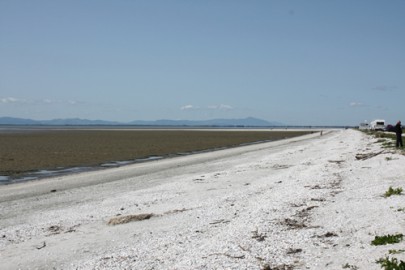Shell barrier beaches ('Chenier plains')
In this section
-
Coastal
- Active sand dunes
- Basic coastal cliffs
- Calcareous coastal cliffs
- Coastal cliffs on acidic rocks
- Coastal cliffs on quartzose rocks
- Coastal rock stacks
- Coastal turfs
- Dune deflation hollows
- Shell barrier beaches ('Chenier plains')
- Shingle beaches
- Stable sand dunes
- Stony beach ridges
- Ultrabasic sea cliffs

Shell barrier beach ('Chenier plains') (Janine Faulknor, Te Ara, the Encyclopedia of New Zealand, © Crown Copyright 2005 - 2011 Ministry for Culture and Heritage, New Zealand).
A shell barrier beach is a prograded coastal plain comprising shell fragments and coarse sand that is moved by longshore drift and carried landwards through wash action to form bars on the foreshore (Woodroffe et al. 1983). They are globally rare. The largest in New Zealand, at Miranda, is the only one in the world still aggrading. The shells are mainly those of little neck clams (Austrovenus stutchburyi), but other molluscs may be present. Shell barrier beaches would once have supported small-leaved shrubs such as salt marsh ribbonwood (Plagianthus divaricatus), mingimingi (Coprosma propinqua)and mānuka (Leptospermum scoparium), but these have mostly disappeared.
Synonyms
Chenier Plains
Notable flora and fauna
The Firth of Thames is best known as an internationally important feeding ground for up to 25,000 birds at any one time, most of which are migratory. Three endemic bird species breed at Miranda: the endangered New Zealand dotterel (Charadrius obscurus), the endangered black-billed gull (Larus bulleri) and variable oystercatcher (Haematopus unicolor). Non-endemic breeding species include the white-faced heron (Ardea novaehollandiae), pied stilt (Himantopus himantopus), black-backed gull (Larus dominicanus), pukeko (Porphyrio porphyrio), banded rail (Rallus philippensis), white-fronted tern (Sterna striata) and spur-winged plover (Vanellus miles).
Many bird species that breed in the Northern Hemisphere overwinter here during the southern summer, including the bar-tailed godwit (Limosa lapponica), and red knot (Calidris canutus), and 40% of the world population of the endemic wrybill (Anarhynchus frontalis) overwinters here. Other notable species include the nationally endangered Australasian bittern (Botaurus poiciloptilis), as well as grey teal (Anas gracilis), New Zealand shoveler (Anas rhynchotis ssp. variegata), New Zealand kingfisher (Halcyon sancta ssp. vagans), cattle egret (Bubulcus ibis), and royal spoonbill (Platalea regia).
Rare and threatened plants include the nationally critical grey saltbush (Atriplex cinerea) and the naturally uncommon New Zealand musk (Mimulus repens).
Threat status
Critically endangered (Holdaway et al. 2012)
Threats
Direct human impacts include drainage, pastoral development and stock damage, and shell extraction in some areas. This high level of disturbance and removal of native vegetation has allowed exotic weeds to pose a serious threat. At Miranda, less than 10% of native vegetation remains and most areas are dominated by numerous exotic herbs and graminoids of which saltmarsh sedge (Carex divisa) and saltmarsh rush (Juncus gerardii) are prominent. Because of the abundance of exotics in these ecosystems, they are the first plants to colonise newly formed bare shell banks. Additionally, demand for coastal property poses a threat to shell barrier beaches around Auckland. Indirect threats include water quality deterioration, sediment deposition and nutrient loading caused by river discharges and unsuitable farming practices (intensive stocking, lack of fences) in the catchment.
Where do they occur?
Shell barrier beaches are confined to the Auckland region, primarily to the Hauraki Gulf and the adjoining Waitemata Harbour. Miranda, in the Firth of Thames, Hauraki Gulf, is mostly Crown Land managed by DOC, although the wider area (also part of the Chenier plain) is privately owned and grazed. Miranda is included in the Firth of Thames Ramsar site, which is designated as an internationally significant wetland under the Convention on Wetlands. Other sites in the Hauraki Gulf include Stillwater (Stillwater shell barrier spits) and Wade Heads (Weiti River). Sites in the Waitemata Harbour include Shoal Bay (Jutland Road shell barrier beach, Eversleigh Road shell barrier beach), Ngataringa Bay (Norwood Road shell barrier spit), Hobson Bay (Hobson Bay shell barrier island and Portland Road), and Pollen Island (Pollen Island shell barrier).
Further reading
Brownell W 2008. Muddy Feet Phase II. Firth of Thames Ramsar Site Gap Analysis: Working Paper. Muddy Feet Steering Group by Tikapa Kahawai Coastal/Marine Advisory Service Kaiaua, New Zealand.
Healy T 2002. Muddy coasts of mid-latitude oceanic islands on an active plate margin – New Zealand. in T. Healy, Y. Wang and J-A Healy (Editors) Muddy Coasts of the World: Processes,Deposits and Function. Elsevier Science, Amsterdam, pp. 347 - 374.
Merrett M, Clarkson B 1997. Vegetation survey of the foreshore from Miranda to Kaiaua. Report prepared for the Department of Conservation by the Waikato Botanical Society.
Strahan DC 1997. The plant ecology of Miranda wetland: restoration options. Unpublished MSc thesis, University of Waikato, Hamilton, New Zealand.
Woodroffe CD, Curtis RJ, McLean RF 1983. Development of a Chenier Plain, Firth of Thames, New Zealand. Marine Geology 53: 1-22.
Links
Chenier Plains: An internationally significant landform (Miranda shorebird centre)
Hauraki Gulf State of the environment report


